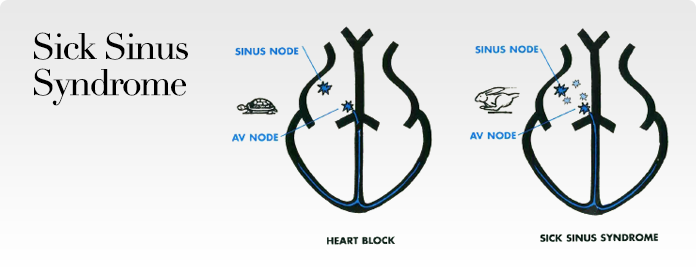
Goldberger JJ, Johnson NP, Gidea C (2011) Significance of asymptomatic bradycardia for subsequent pacemaker implantation and mortality in patients > 60 years of age. Sutton R, Kenny RA (1986) The natural history of sick sinus syndrome. Br Med J 280:139–141Īlt E, Volker R, Wirtzfeld A et al (1985) Survival and follow-up after pacemaker implantation: comparison of patients with sick sinus syndrome, complete heart block and atrial fibrillation. Shaw DB, Holman RR, Gowers JI (1980) Survival in sino-atrial disorder (sick sinus syndrome). Gann D, Tolentino A, Samet P (1979) Electrophysiologic evaluation of elderly patients with sinus bradycardia. In: Consolo F, Arrigo F, Oreto G (eds) La sindrome del seno malato. Circulation 96:260–266īaldi N, Castelli M, Alberti E et al (1979) La sindrome del seno malato: storia naturale. The THEOPACE study: a randomized controlled trial. Pacing Clin Electrophysiol 15:2055–2060Īlboni P, Menozzi C, Brignole M et al (1997) Effect of permanent pacemaker and oral theophylline in sick sinus syndrome. Sgarbossa EB, Pinsky SL, Jaeger FJ et al (1992) Incidence and predictors of syncope in paced patients with sick sinus syndrome.

Circulation 102:1807–1813Īlboni P, Brignole M, Menozzi C et al (1999) Is sinus bradycardia a factor facilitating overt heart failure? Eur Heart J 20:252–255 Sparks PB, Jayaprakash S, Vohra J et al (2000) Electrical remodeling of the atria associated with paroxysmal and chronic atrial flutter. Holm H, Gudbiartsson DF, Sulem P et al (2011) A rare variant in MYH6 is associated with high risk of sick sinus syndrome.

Yeh YH, Burstein B, Qi XY et al (2009) Funny current downregulation and sinus node dysfunction associated with atrial tachyarrhythmia: a molecular basis for tachycardia-bradycardia syndrome. Br Heart J 40:1384–1389īenson DW, Wang DW, Dyment M et al (2003) Congenital sick sinus syndrome caused by recessive mutations in the canine sodium channel gene (SCN5A). Circulation 94(115):1921–1932ĭemoulin JC, Kulbertus HE (1978) Histopathological correlates of sinoatrial disease. Circulation 94:2953–2960ĭobrzynski H, Boyett MR, Anderson RH et al (2007) New insights into pacemaker activity: promoting understanding of sick sinus syndrome. N Engl J Med 346:1854–1862Įlvan A, Wylie K, Zipes DP et al (1996) Pacing-induced chronic atrial fibrillation impairs sinus node function in dogs. Ventricular pacing or dual-chamber for sinus-node dysfunction.
#Sick sinus syndrome trial
Lamas GA, Lee KL, Sweeney MO et al (2002) Mode selection trial in sinus-node dysfunction.

Patients with syncope and permanent mild sinus bradycardia, without much prolonged SN recovery time, should be managed as the patients with syncope and normal sinus rate. However, a depressed SN automaticity, expressed by much prolonged SN recovery time, suggests a role of SN dysfunction in the origin of syncope. The results of some clinical studies, where head-up tilt testing and carotid sinus massage with the method of symptoms were performed in patients with syncope and sinus bradycardia, seem to confirm a reflex mechanism as the cause of syncope in most cases. Some clinical data suggest that a reflex mechanism is likely to be involved in many patients with syncope and sinus bradycardia: (1) the course of syncope is very variable from patient to patient (2) syncope does not recur in more than half of unpaced patients with SSS (3) syncope recurs in up to 20 % of SSS patients during long-term follow-up, despite adequate pacing (4) the prognosis does not appear to be different between SSS patients with and without neurologic symptoms. In the absence of such correlation, the mechanism of undocumented intermittent symptoms such as syncopal spells in patients with permanent mild sinus bradycardia remains uncertain. Sick sinus syndrome (SSS) can be diagnosed only when there is a clear correlation between symptoms and sinus node (SN) dysfunction.


 0 kommentar(er)
0 kommentar(er)
